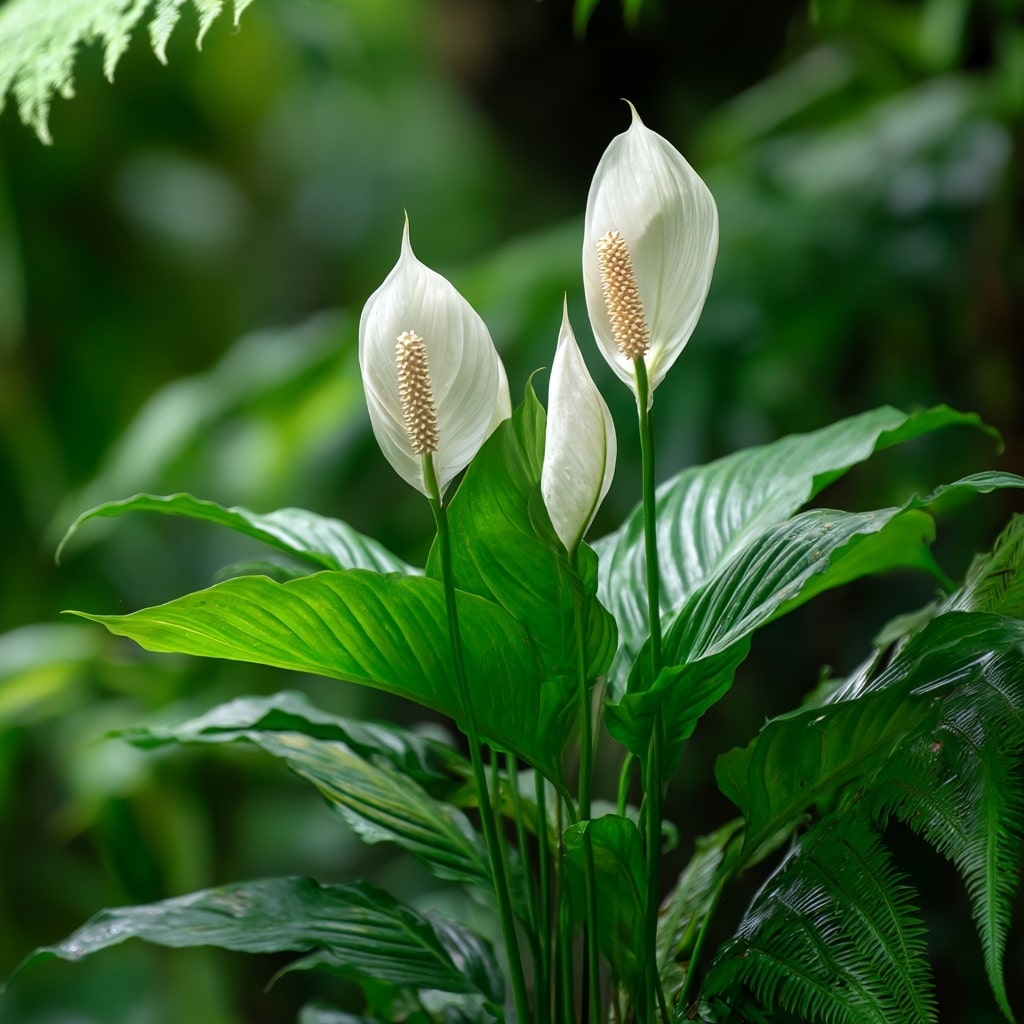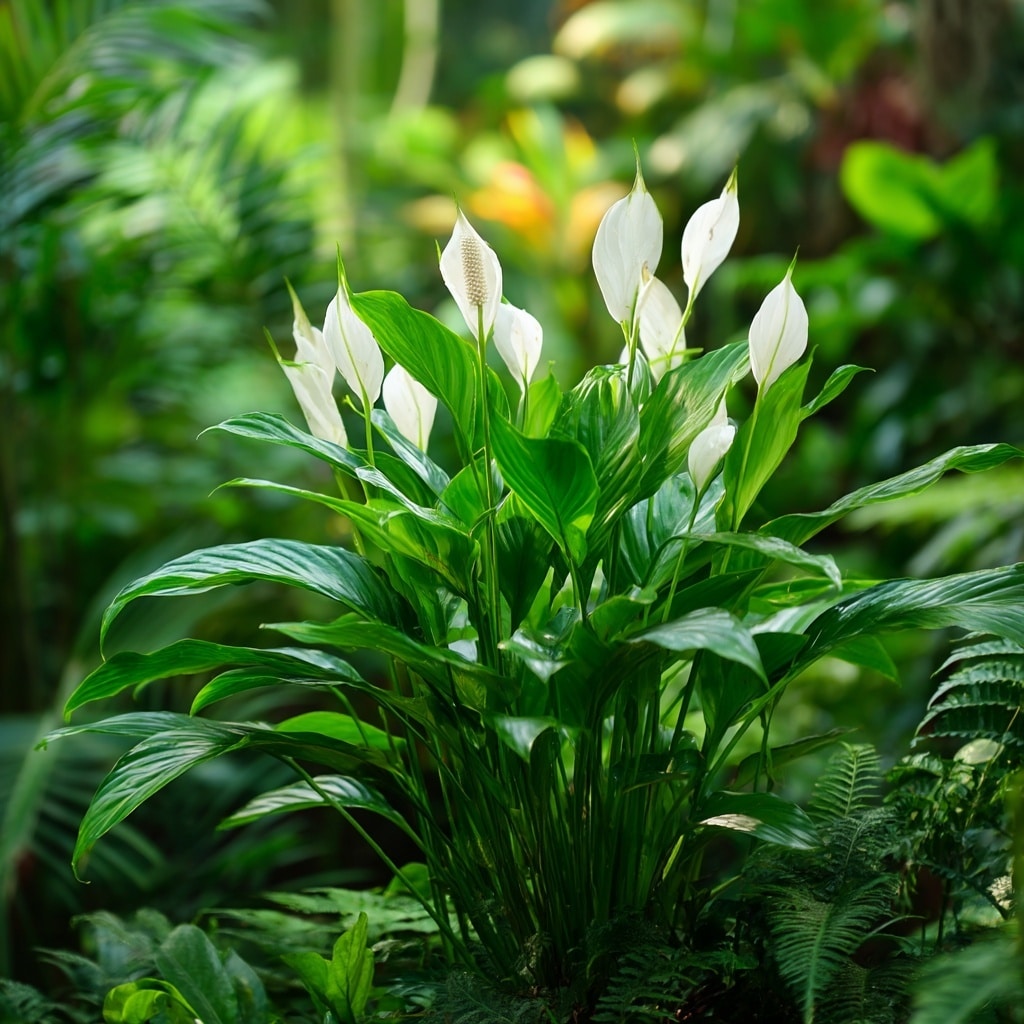Peace lily care doesn’t have to be complicated—even if you’re just starting out with houseplants. With their elegant white blooms and deep green leaves, peace lilies bring a calming, tropical vibe to any indoor space. But to keep them truly thriving, it’s important to understand their basic needs.
These tropical beauties are more than just eye candy. They’re natural air purifiers and excellent communicators, often letting you know exactly when something’s off—like droopy leaves when thirsty. By giving your peace lily the right environment, watering schedule, and occasional attention, you’ll enjoy a lush, happy plant that thrives year-round.
Table of Contents
About the Peace Lily
Peace lilies (Spathiphyllum) are native to the tropical rainforests of Central and South America, where they thrive in warm, humid environments beneath dense jungle canopies. This natural habitat gives us important clues for effective peace lily care indoors: filtered light, steady moisture, and consistent warmth.
One of the most popular varieties for indoor growing is the ‘Mauna Loa,’ known for its large, paddle-shaped leaves and striking white spathes. Though often mistaken for flowers, these white “blooms” are actually modified leaves surrounding a central spadix.
Aside from their visual charm, peace lilies are also valued for their ability to clean indoor air. Studies have shown they can help reduce pollutants like benzene, formaldehyde, and carbon monoxide—making them both beautiful and beneficial for your home.
With just a bit of the right care, these resilient plants can be long-lasting companions in any indoor garden.
Peace Lily Care Basics
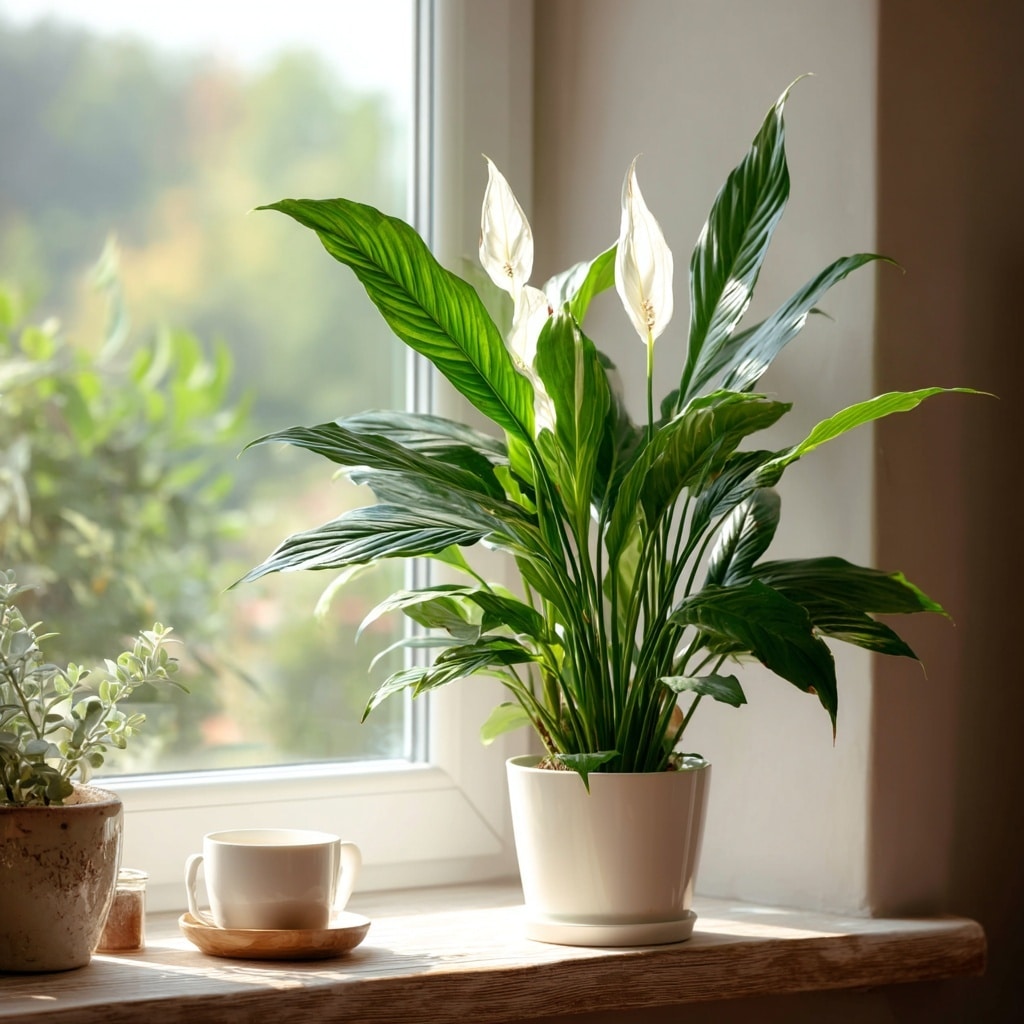
Light Requirements

Light is one of the most important aspects of peace lily care. These plants prefer bright, indirect light—similar to the dappled sunlight found beneath rainforest trees. A spot near an east- or north-facing window typically works best.
Avoid placing your peace lily in direct sunlight, which can cause brown, scorched patches on the leaves. On the other hand, too little light can result in sparse blooms, leggy growth, and dull foliage. If natural light is limited, consider supplementing with a small grow light to mimic the conditions peace lilies love.
While they can survive in low-light areas, they won’t thrive long-term without sufficient indirect light. For vibrant foliage and occasional blooms, make light a priority.
Soil Requirements

Peace lilies need well-draining soil that stays moist without becoming soggy. A quality indoor potting mix with ingredients like peat moss or coco coir is ideal. These materials retain moisture while allowing for airflow around the roots.
To improve drainage, mix in some perlite or coarse sand. This helps prevent root rot, one of the most common issues in peace lily care indoors.
When repotting, always choose containers with drainage holes. Trapped water is the fastest way to stress your plant.
Temperature and Humidity
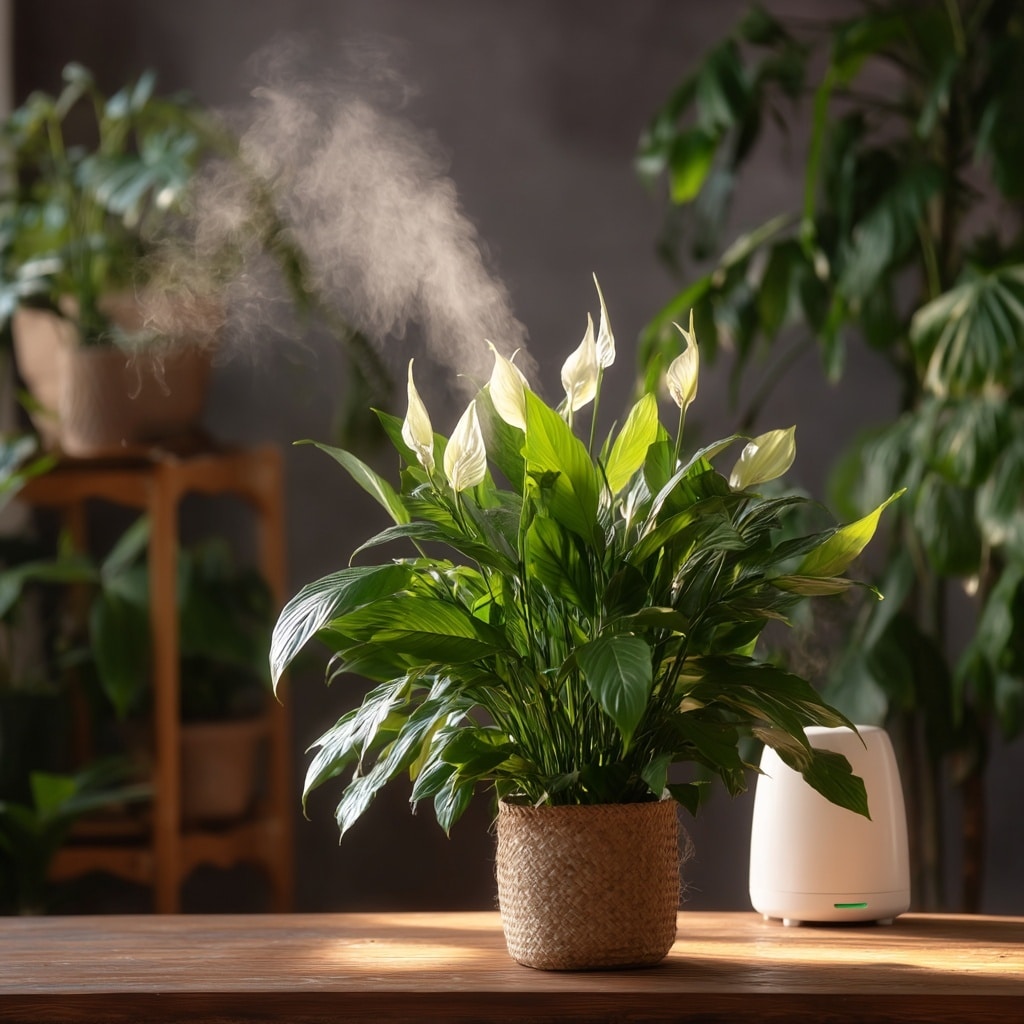
As tropical plants, peace lilies thrive in temperatures between 65°F and 80°F (18°C to 27°C). They don’t handle cold drafts or temperature swings well, so keep them away from air vents, exterior doors, or windows during the colder months.
Humidity is equally important. Dry indoor air—especially during winter—can lead to crispy leaf edges. Here are a few ways to increase humidity around your plant:
- Mist the leaves with filtered or distilled water
- Place the pot on a tray filled with water and pebbles
- Group your peace lily with other plants to create a humid microclimate
- Use a room humidifier if the air is very dry
Maintaining the right humidity not only improves leaf health, it also prevents pests and encourages steady growth.
Watering Your Peace Lily
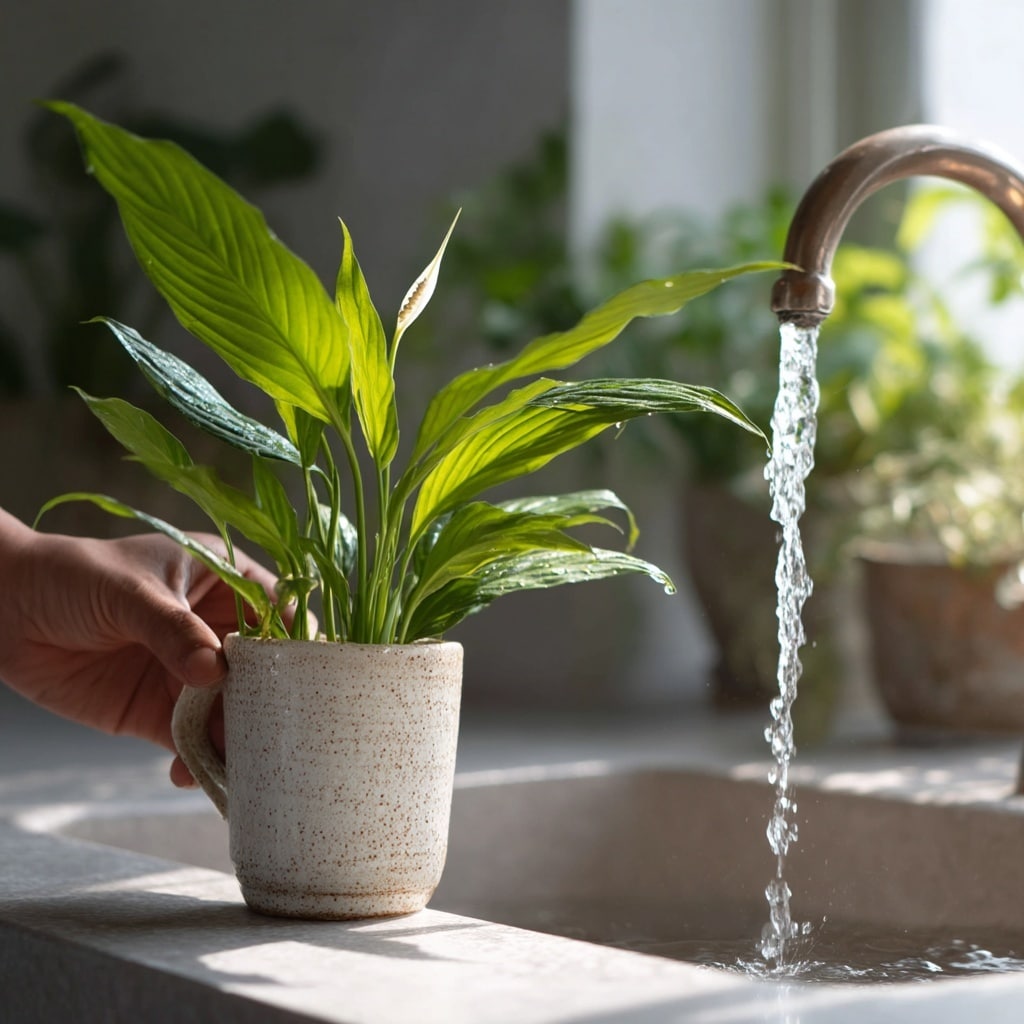
Getting the watering routine right is at the heart of successful peace lily care. These plants like their soil to stay slightly moist—but never soggy. Overwatering is one of the most common problems and can quickly lead to root rot.
Let the top inch of soil dry out before watering again. A simple finger test works: push your finger about an inch into the soil. If it feels dry, it’s time to water. Alternatively, you can use a moisture meter for more precision.
When watering, give the plant a deep soak until excess drains from the bottom. Always empty the saucer beneath the pot to prevent standing water.
Peace lilies will also tell you when they’re thirsty. Drooping leaves are a dramatic, but harmless, sign that it’s time for a drink. They typically perk up within a few hours of watering.
Watering Tips:
- Use distilled or rainwater if possible—peace lilies are sensitive to chlorine and other chemicals in tap water
- Reduce watering frequency in winter when growth slows
- Watch for yellowing leaves (a sign of too much water) or crispy brown tips (a sign of underwatering or dry air)
By observing your plant and sticking to a consistent routine, you can avoid most watering issues and keep your peace lily healthy and hydrated.
Fertilizing and Foliage Care
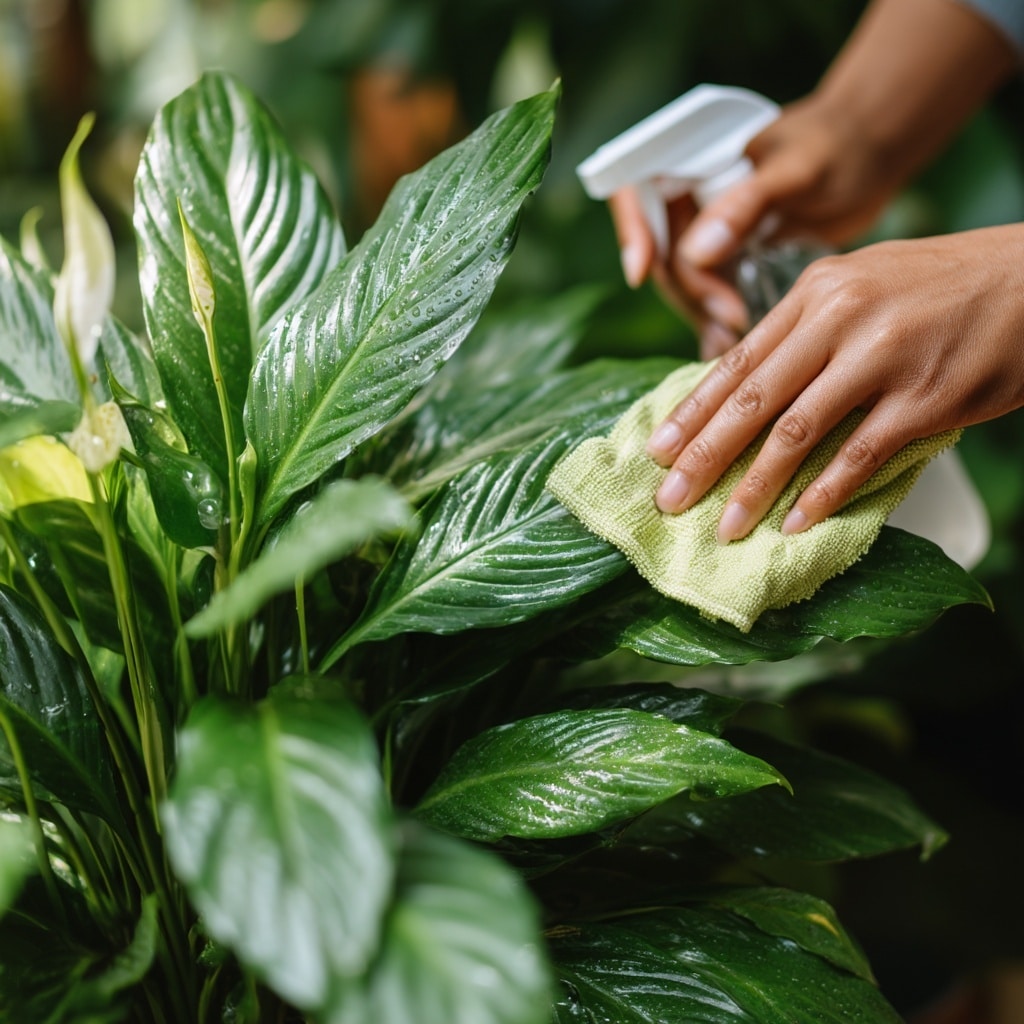
Peace lilies are not heavy feeders, but a little nutrition during their growing season can go a long way. For proper peace lily care, apply a balanced, water-soluble houseplant fertilizer—such as a 20-20-20 formula—once every 4 to 6 weeks in spring and summer.
Always dilute the fertilizer to half strength to avoid overfeeding, which can lead to leaf burn and salt buildup. Skip fertilizing during fall and winter, when the plant’s growth naturally slows down.
If your peace lily seems to be growing slowly or producing fewer blooms, a gentle feeding schedule might help restore its vigor.
Foliage Care
Peace lilies have broad, lush leaves that tend to collect dust—especially in drier indoor environments. A light buildup of dust can block sunlight and hinder photosynthesis, which impacts plant health.
To keep your plant looking its best and functioning well:
- Wipe the leaves gently with a damp, soft cloth every couple of weeks
- Avoid using commercial leaf shine products, which can clog pores
- Use filtered or distilled water for cleaning to avoid water spots and mineral residue
Regular leaf cleaning is a small task that offers big rewards. Not only will your plant look more vibrant, but it’ll also be better able to absorb light and thrive in its environment.
Repotting Your Peace Lily

Like many indoor plants, peace lilies benefit from repotting every 1 to 2 years. This is especially important if the plant becomes root-bound, which can restrict growth and affect overall health. A tightly packed root system can also reduce the plant’s ability to absorb water and nutrients effectively.
Signs your peace lily needs repotting:
- Roots growing out of the drainage holes
- Water runs straight through the pot without soaking in
- Wilting despite regular watering
- Slowed growth or fewer blooms
When repotting:
- Choose a pot that’s 1 to 2 inches larger in diameter than the current one
- Use fresh, well-draining potting mix with moisture-retaining elements like coco coir or peat moss
- Gently loosen the root ball and trim away any rotted or tangled roots
- Water thoroughly after repotting and let the plant adjust in indirect light
Spring is the ideal time to repot, as the plant enters its natural growth phase. Repotting also gives you a chance to refresh depleted soil, improving the overall quality of your peace lily care routine.
Pruning and Deadheading

Pruning is a simple but essential part of peace lily care, helping your plant stay tidy, healthy, and full of energy. Regularly removing damaged or aging foliage directs energy toward new growth and encourages a fuller appearance.
Here’s what to prune and how:
- Yellow or brown leaves: Use clean, sharp scissors or pruners to cut them off at the base of the stem
- Spent blooms: Once a spathe starts to fade or turn green, cut it down as close to the base as possible
- Dead stems: Trim any mushy or dried-out stems to prevent disease from spreading
Deadheading spent blooms isn’t just for looks—it helps the plant focus on foliage and future flowering. Always sterilize your pruning tools with rubbing alcohol before and after use to reduce the risk of spreading disease.
Routine grooming every few weeks keeps your peace lily looking its best and extends its lifespan, especially when paired with proper watering, light, and feeding.
Common Pests and Diseases
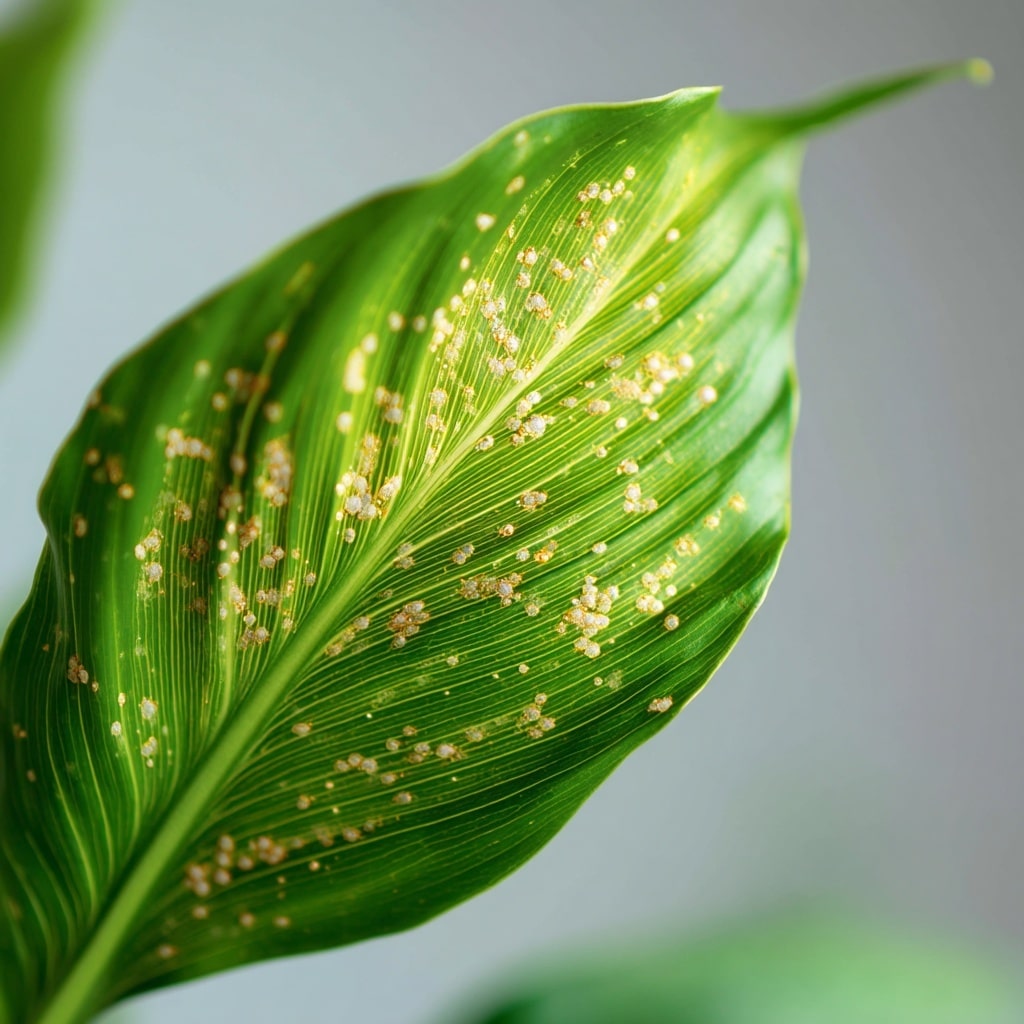
While peace lilies are generally hardy, they can occasionally attract pests or develop diseases—especially when conditions aren’t ideal. Staying ahead of these issues is a key part of long-term peace lily care.
Common Pests:
- Mealybugs: These small, white insects look like bits of cotton and hide in leaf joints. Treat with a cotton swab dipped in rubbing alcohol or use neem oil or insecticidal soap.
- Spider Mites: If you notice fine webbing or tiny moving dots on the undersides of leaves, mites may be the culprit. Increase humidity and spray the plant with neem oil or insecticidal soap.
- Fungus Gnats: These tiny flying insects thrive in overly wet soil. Let the top layer of soil dry out between waterings and consider adding a layer of sand to deter them.
Common Diseases:
- Root Rot: Caused by consistent overwatering and poor drainage. Symptoms include yellowing leaves, a sour smell, and mushy roots. To fix this, remove the plant from its pot, trim damaged roots, and repot in fresh, dry soil.
- Leaf Spot or Blight: Fungal infections can leave brown or black spots on leaves. Improve air circulation, avoid getting water on the foliage, and remove affected leaves promptly.
Maintaining proper watering habits, increasing airflow, and regularly inspecting your plant will help prevent most of these issues. The earlier you catch a problem, the easier it is to resolve—and your peace lily will thank you with vibrant, healthy growth.
Propagation Methods

One of the most rewarding aspects of peace lily care is the ability to propagate your plant and grow new ones. Propagation is simple, especially if your peace lily has grown large and developed multiple crowns or clusters.
1. Division (Most Effective Method)
Peace lilies are best propagated by division during repotting. Here’s how:
- Gently remove the plant from its pot and shake off excess soil
- Locate natural separations in the root system where individual clusters of leaves (crowns) have their own roots
- Carefully divide the plant, ensuring each section has both roots and leaves
- Replant each division in its own pot with fresh soil
- Water thoroughly and place in bright, indirect light to help them adjust
This method allows you to produce strong, established plants with minimal stress.
2. Stem Cuttings (Less Reliable)
While not as commonly used, some gardeners attempt propagation through stem cuttings:
- Take a cutting with at least one leaf and a small portion of stem
- Place in a jar of clean water or moist potting mix
- Keep in a warm, humid spot with indirect light
- If rooting in water, change the water every few days
Note: This method is slower and less reliable than division, but can still work with patience and the right conditions.
Whether you want to expand your indoor jungle or share a healthy plant with a friend, propagation is a great way to multiply your peace lily success.
Troubleshooting Guide
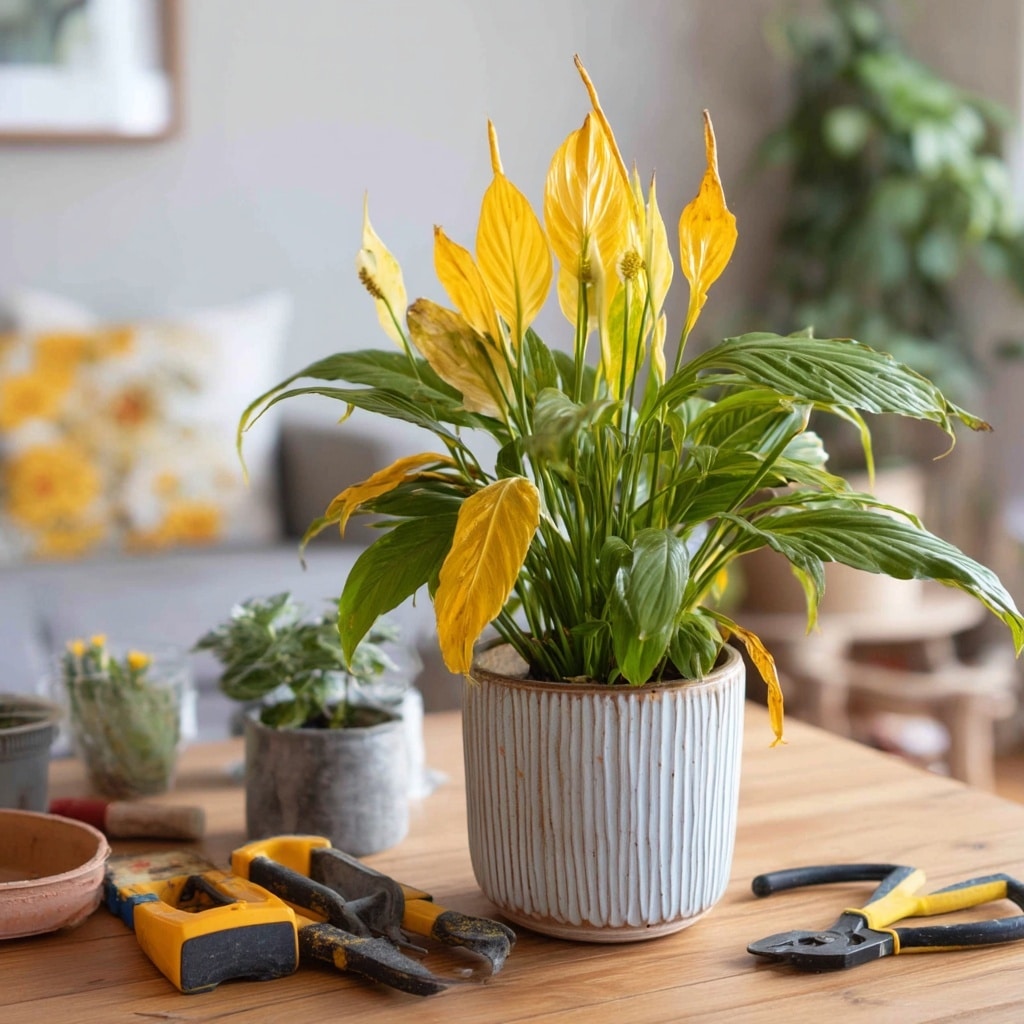
Even with the best intentions, every plant parent runs into issues now and then. Recognizing the signs early and adjusting your peace lily care routine can prevent small problems from turning into bigger ones.
Yellowing Leaves
Likely Causes:
- Overwatering (most common)
- Nutrient deficiency
- Natural aging (lower leaves)
What to Do:
- Check soil moisture and drainage
- Reduce watering frequency
- Trim away the yellow leaves at the base
Drooping Leaves
Likely Causes:
- Underwatering (most common)
- Overwatering
- Temperature shock or drafts
What to Do:
- Check soil dryness
- Water thoroughly if dry
- Ensure the plant is in a stable, draft-free location
Brown Leaf Tips
Likely Causes:
- Dry air or low humidity
- Inconsistent watering
- Fertilizer burn
- Tap water with chemicals
What to Do:
- Increase humidity with a pebble tray or humidifier
- Water with distilled or rainwater
- Use fertilizer at half strength
Lack of Blooms
Likely Causes:
- Insufficient light
- Overwatering or underwatering
- Lack of nutrients
- Peace lilies may also need a dormancy period with less water and cooler temps
What to Do:
- Move to a brighter (but indirect) location
- Review your watering and feeding routine
- Allow for a rest period in cooler months
Conclusion
Proper peace lily care is all about balance: not too wet, not too dry, and just enough light and warmth. When you meet this plant’s simple needs—indirect sunlight, well-draining soil, consistent watering, and occasional feeding—it will reward you with vibrant foliage and elegant white blooms.
Whether you’re nurturing your first peace lily or have a home full of houseplants, these tropical beauties are a joy to grow and easy to maintain once you understand their preferences. Keep an eye on their leaves, adjust your care as the seasons change, and don’t be afraid to prune or repot when needed.
With just a little attention, your peace lily will thrive for years to come.

